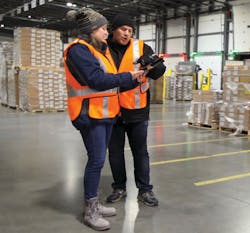Traditional methods of coordinating logistics operations like spreadsheets, two-way radios, and yard checks on foot provide limited and outdated information that can make communication difficult. These shortcomings often lead to frustrated customers and employees, slowed operations, and risks to a company’s workforce, reputation, and bottom line.
Recently, paperless software solutions have been developed to bring an enhanced sense of clarity and order to logistics operations. Instead of using spreadsheets and radios, this software allows everyone to communicate in real-time, bringing the long-awaited “smart dock” from concept to reality.
Smart Controls: The First Step
The development of programable, data-capturing equipment was the first step in this evolution.
Smart controls that can interlock loading dock equipment, from vehicle restraints to levelers and dock doors, are a good example. Not only can they be programmed to operate exclusively in a safe sequence of operation, but they also now provide performance and usage information.
Unfortunately, while these previously low-tech products could now provide significant amounts of data, there was still no way to distill all that data into actionable insights. However, that has changed. The most advanced dock management systems now connect smart equipment and controls with an Industrial Internet of Things (IIoT) platform.
IIoT Brings it All Together
The information provided by IIoT can help managers uncover potential challenges and proactively identify solutions, driving behavioral and process changes. IIoT is particularly adept at monitoring and communication, which can have a significant impact on organizational safety, as well as boost efficiency and productivity.
In fact, 93% of manufacturers agree that IoT benefits exceed risks, as reported in an Industry Week study.
At loading docks with data-capturing smart controls, equipment enhanced with IIoT capabilities can give facilities a more advanced look at what’s happening during logistics operations.
For example:
- Vehicle restraints: By connecting with IIoT loading dock management software, these pieces of equipment can share information on which loading docks are available for loading/unloading, as well as when a vehicle restraint goes into a fault, so facility managers can immediately react to a potentially unsafe situation.
- Audio and visual light communications systems: These motion-sensor activated systems indicate when there is a restraint fault if someone enters an unsecured trailer or tries to disengage a trailer with activity inside the trailer.
- The system also tracks when doors go up, levelers down, etc. as well as how long and how many cycles they’ve recorded.
Leading-edge logistics management software provides managers with an intuitive loading dock dashboard that allows them to review current trends and historical data. With those insights, they can make more data-driven decisions and identify additional opportunities for improvement they could never see before.
The Benefits of Real-Time Information
Long-term insights are not the only benefit, however. By providing real-time information, the system brings a new level of clarity, order, and productivity to current operations for customers, material handling employees, and the entire operation.
This instant information can be accessed through all enabled screens, tablets on forklifts, and other connected mobile devices. Among other things, it shows which docks are open, which are in use, how long loading or unloading has been going on, when trailers are held in detention waiting for a dock position, and other critical details.
Using this information, managers can coordinate appointments, monitor dwell times, and help keep docks fully in use. Additionally, the system provides carriers the option to skip long lines via self-check-in and updates them on their load status with text alerts. Allowing logistics personnel to seamlessly communicate in real-time can drastically reduce costly detention and demurrage charges.
Connecting through the IIoT software solution also simplifies scheduling. By funneling all appointments and updated schedules through one central location, the need for multiple spreadsheets or excessive paperwork is virtually eliminated. This improves worker productivity while simultaneously cutting down on errors that can happen with various spreadsheets and logbooks.
Other benefits include:
- Reduced labor costs: This system makes it easier and less time-consuming to train new employees. Additionally, the centralized information and intuitive dashboard improve current worker efficiency, helping reduce overall man-hours.
- Quiet and clutter-free communication: A singular system provided by IIoT can reduce radio noise and paper spreadsheets.
- Shipping accuracy: The central platform updates in real-time, instead of requiring changes to be made in multiple spreadsheets and logbooks.
- Appointment management: Loading dock schedulers can seamlessly enter several logistics appointments at the same time.
- Reporting and interface: Facility and operations managers can more readily identify improvements through robust reporting and an easy drill-down interface.
Improving Safety
Instead of reacting to accidents, companies are increasingly looking to proactively address potential safety issues with improved training and safety-oriented equipment like:
- Interlocking “safe sequence” dock controls
- Motion sensor-activated audio and visual communications systems at dock openings and intersection warning systems
- Doors that automatically reverse when their photo-eye is tripped
- Dock levelers with power-up/power-down controls (rather than power-up/gravity-down)
In facilities with smart controls, IIoT can connect pieces of equipment for a more advanced look at operational activities. It can help identify potentially unsafe operations and send real-time alerts about them.
IIoT is particularly useful for tracking and logging events and actions that safety managers would likely want to know about, but employees may be hesitant to report, thus significantly enhancing near-miss reporting procedures.
For example, an IIoT smart dock can identify, record, and send alerts if a trailer restraint becomes unlocked when a trailer is still at the dock; if an employee attempts to operate the leveler without engaging the restraint; if a dock door is left open with no barrier across it; or if there is forklift or pedestrian activity in an unsecured trailer.
Conversely, the motion sensor-based light communications system tied to this IIoT platform also prevents the vehicle restraint from being unlocked when activity is detected inside the trailer and emits a blue light on the leveler outside of the trailer during that time.
The Future is Here
IIoT-driven smart docks aren’t just a concept we’ll see in the future. They’re here. Whether it’s at the loading dock or inside the plant, facilities that have already invested in IIoT are reaping the benefits.
In fact, an Industry Week report revealed that 70% of manufacturers plan to increase their IoT investment within the next 2 years.
This isn’t surprising; given the insights, efficiencies, and broad ROI that IIoT offers, industrial facilities that aren’t taking advantage of it risk falling behind their competition. Now is the time for them to recognize the positive impact IIoT has on all stakeholders and embrace this game-changing technology to start seeing what you are missing.
The information herein is provided as a general reference regarding the use of the applicable product(s) in specific applications. This information is provided without warranty. It is your responsibility to ensure that you are using all mentioned products properly in your specific application and in accordance with all laws and regulations.
About the Author
Tim Kubly
Tim Kubly has more than 14 years in the materials handling industry, including 8 years with Rite-Hite. As the business development manager for Rite-Hite Digital Solutions, Kubly is leading Rite-Hite’s initiative to connect customers with equipment, providing solutions through dock and trailer management software.

